Getting your restaurant to the first page of Google doesn’t have to be as difficult as it seems. Sure, there is competition, but what industry doesn’t have competition? Time and time again, marketers and business owners have found ways to rise above their competitors, so why can’t you?
Today we will be outlining 4 steps you can take to improve your restaurant’s visibility in the search engines.
1. Optimize Your Google My Business (GMB) Page
When it comes to local SEO, nothing is more important than Google My Business. Think of your GMB as your secondary homepage: it’s the first page that users usually see; therefore, it should be your mission to make it so enticing that they want to click through to learn more.
Be Thorough With The Basics: If Google Asks For It, Fill It Out
Start by filling out everything that’s available to you on the backend: your restaurant’s name, address, and phone number; the type of restaurant you are (Chinese, fast food, pizza), a link to your menu, and a short description of what you offer.

We’re located in Wallingford, CT, so I searched “pizza near me.” The top result is Main Street Pizza in Wallingford. Notice that they labeled themselves a “Pizza restaurant,” and they offer a link to their menu, as well as places where users can order from.
This example also shows us areas that can be improved. Notice “Columbus day might affect these hours?” Setting holiday hours can separate you from the pack.
Boost Click-Through With Images, Videos, & Posts
At its core, SEO is about creating content that searchers want. What do people want from restaurants? Pictures of the food they serve. Upload a gallery of rich images: showcase mouthwatering entrees and appetizers.
While your cuisine should be top of mind, be sure to take pictures of your establishment, and upload them to the “atmosphere” section:
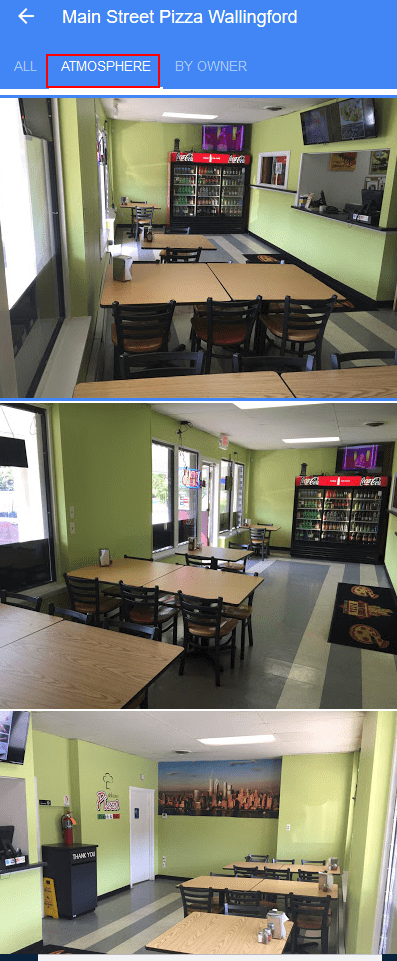
Pictures like this let me know that this isn’t strictly a place for pick-up. These images answer questions like: can I sit down and eat? Is it just a grab-and-go? Is it nice enough for a romantic dinner? Define who you want to be, and state it with pictures like this.
In April 2018, Google added a section for videos. These videos can only be 30 seconds long, so pick a delicious-looking dish and promote it. If people come to your establishment for the atmosphere, then showcase that instead.
In addition to images and videos, be sure to utilize Google posts. Posts allow you to promote events and specials: they can be a max of 300 words, and they allow you to link back to your site with “reserve,” “sign up,” “buy,” and “get offer.” For more information about how to set up and utilize Google posts, check out our step-by-step guide.
2. Build Citations & Maintain a Consistent NAP
According to Bright Local’s recent study, local businesses who rank on the first page of Google have an average of 81 citations. It’s true that citations are an important component of local SEO, but do you really need 81 citations? In our experience, no: Keyword Performance does build citations, but we focus more on relevancy than volume. That being said, we do agree with Bright Local’s ‘top 10’ list:
● Facebook
● Yelp
● Mapquest
● Yellowpages
● Local.yahoo
● Superpages
● Whitepages
● Dexknows
● Bizstanding
In addition, we recommend all social platforms, like Linkedin, Twitter, and Instagram. Once you’ve created these key listings, you should hone in on relevant sites, like Foursquare.
The Best Citations For Restaurants
Aside from Facebook, the only place on the above-mentioned list that you may get customers from is Yelp. The other citations are purely for the search engines. If you’re looking to actually generate leads, then you should focus on:
● Yelp
● Foursquare
● Trip Advisor
● Grub Hub
Like GMB, you should take the time to flesh these profiles out with rich content.
To appease the search engines, it is important to make sure that your name, address, and phone number (NAP) is consistent across the board. Search engines are like easily confused customers. If one part of your menu says the steak is $29.95, but another part lists it as $15.95, your customer will start asking questions. Similarly, if I was interested in visiting a burger joint and one person told me it was on Main St., but another person told me it was on South St., then I would be less likely to know where the place is actually located. Search engines think the same way; therefore, it’s best to ensure that your name, address, and phone number is identical across all citations
Be Mindful of Duplicate Listings
Search engines frown on duplicate listings because it makes it harder for them to decide which is the “true” version. To find duplicates, you should perform a NAP audit. Set up a spreadsheet like this:
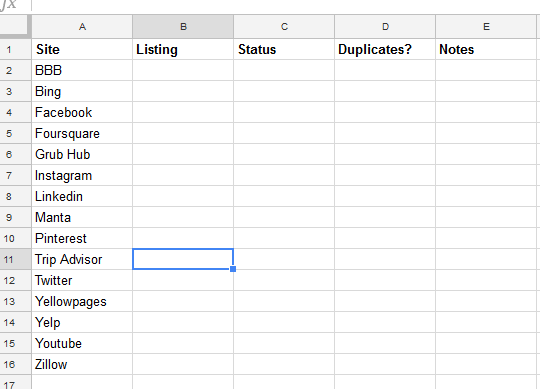
Use search operators to quickly search for duplicates. For example, here’s what comes up when I search inurl:yelp “keyword performance”
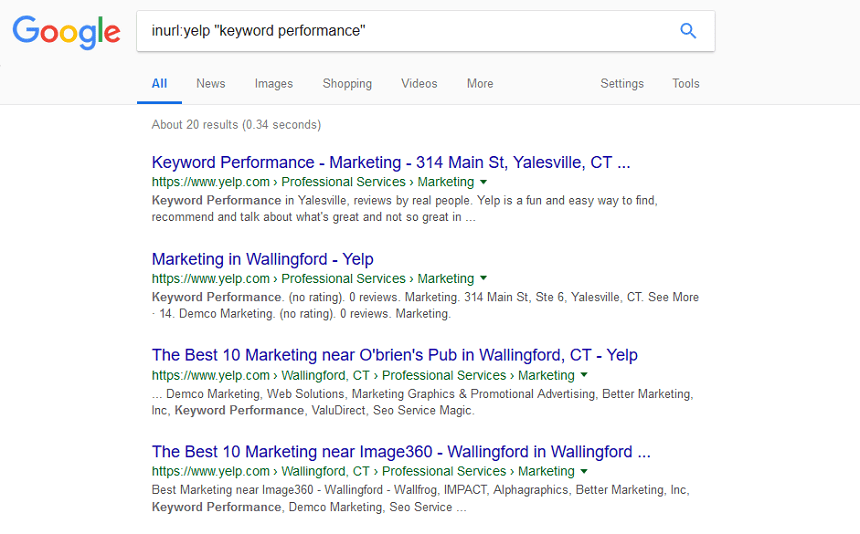
Using the “inurl” operator searches only that domain. Take our advice and pay close attention to Manta and Yellow Pages because duplicates pop up there all the time.
So, what do you do if you find a duplicate listing? Reach out to the webmaster and ask to have it removed. Even if you don’t get a response, some sites, like Google and Yellowpages, offer a “suggest an edit” feature that allows users to submit feedback.
3. On-Page SEO: Write Compelling Title Tags & Meta Descriptions
Titles will forever be the most important written element for customer acquisition. Walk down the check-out aisle in your local grocery store, and study those magazine covers. Forbes and Rolling Stone weren’t always industry giants. They developed clout by delivering quality content, and a lot of that success can be attributed to the enticing titles that they’ve crafted over the years.
Writing titles for the Internet isn’t much different; on the contrary, since you can actually use the search engines to help you, it can be easier. Use Google Suggest to conduct your keyword research and pay attention to the top results for your target queries. In addition to organic results, don’t rule out the winning PPC titles. An ad that receives more clicks will beat an ad that costs more.
In addition to Google Suggest, try SEM Rush’s free “keyword magic tool.” The magic tool pulls all these “suggested” phrases, and even gives you some search volume to help you prioritize the words you should be using:
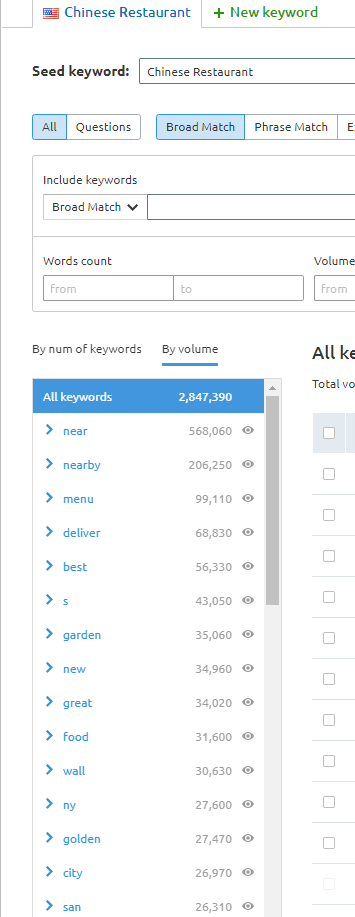
As you can see, words like “best,” “deliver,” and “great” are all heavily searched together with “Chinese restaurant,” so incorporating these into your titles and descriptions should help to improve click-through.
Brian Dean’s extensive copywriting guide is also worth a read. Like all great copywriters, Brian advocates the use of power words, like:
● Today
● Right now
● Fast
● Works quickly
● Step-by-step
● Easy
● Best
● Quick
● Definitive
● Simple
If you offer pizza delivery, then the word “fast” should be top of mind.
Avoid Lengthy Titles & Descriptions
If your title tag or meta description is too long, then search engines will truncate it with ellipses. To avoid this issue, use a free SERP simulating tool, like this one from SEOMofo. It’s much easier to write when you can actually see what it will look like in the SERPS
4. Use Schema Markup
Schema essentially tells search engines what content actually means, rather than just what it says. While not technically a ranking factor yet, schema is becoming more and more prevalent. SEO’s everywhere have been talking about how important schema is to voice search, so why not include it?
A lot of people hit a wall with schema because they find writing code to be intimidating. Luckily, there are many great tools that generate the code for you. My favorite is Merkle’s Schema Markup Generator:
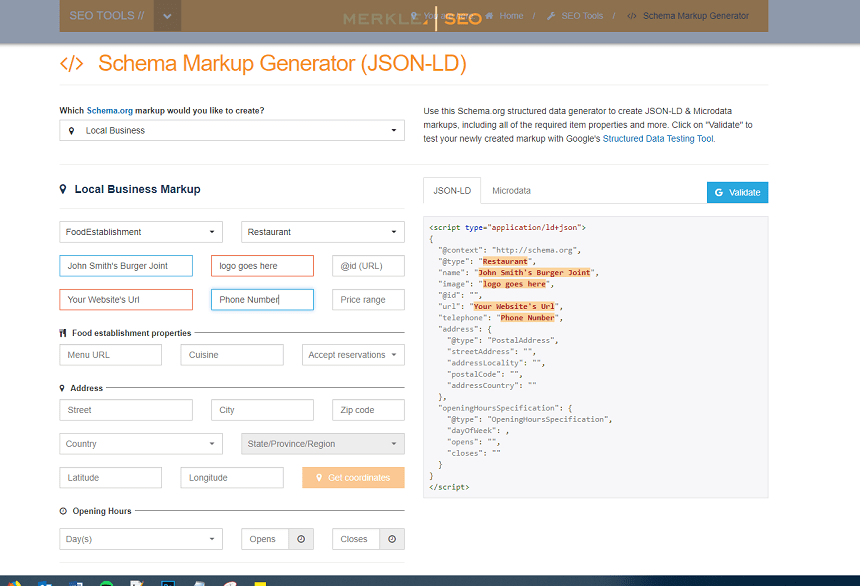
All you have to do here is select “local business” at the top.
Next, select “FoodEstablishment” and “Restaurant”
Fill in the fields, “validate” it with the structured data testing tool, and you’re good to go!
To install, copy and paste the code into the <head> section of your website. If you have a WordPress site, then go to your dashboard, hover over “Appearance,” and click “editor.”
Look at the sidebar on the right and click “header.php”
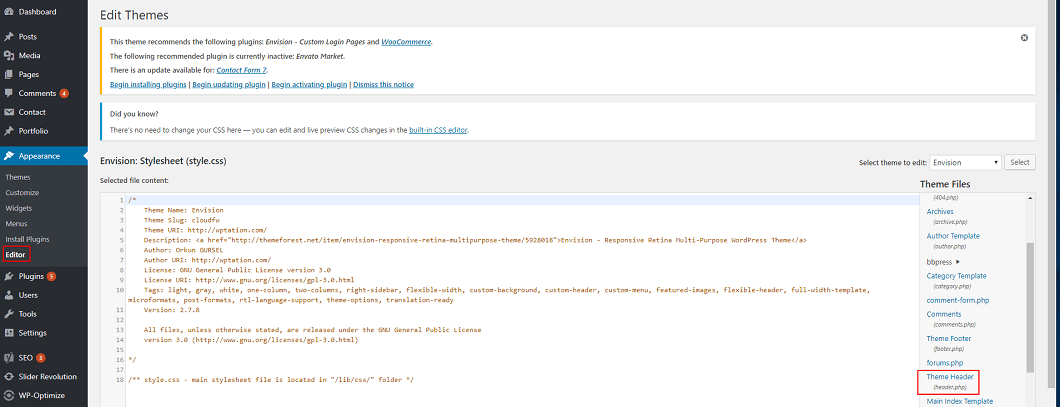
You will get a message from WordPress warning you that you will be making direct edits. Click “I understand”
Hit Control F, and type “/head” in the search box.
This will bring you to the end of the <head> tag, “</head>”
Place your cursor at the end of the line above “</head>” and hit return
Paste your schema code here, hit “update file” at the bottom, and then test your site with the structured data testing tool. Plug the URL of your homepage into the tool and hit “run test”
If done successfully, you’ll see LocalBusiness on the right-hand side
If you have any SEO tips for restaurants, then feel free to leave a comment.
If you’re a restaurant owner in Connecticut, then drop us a line: we’re always eager to help businesses that are in our own backyard!
 logo
logo
